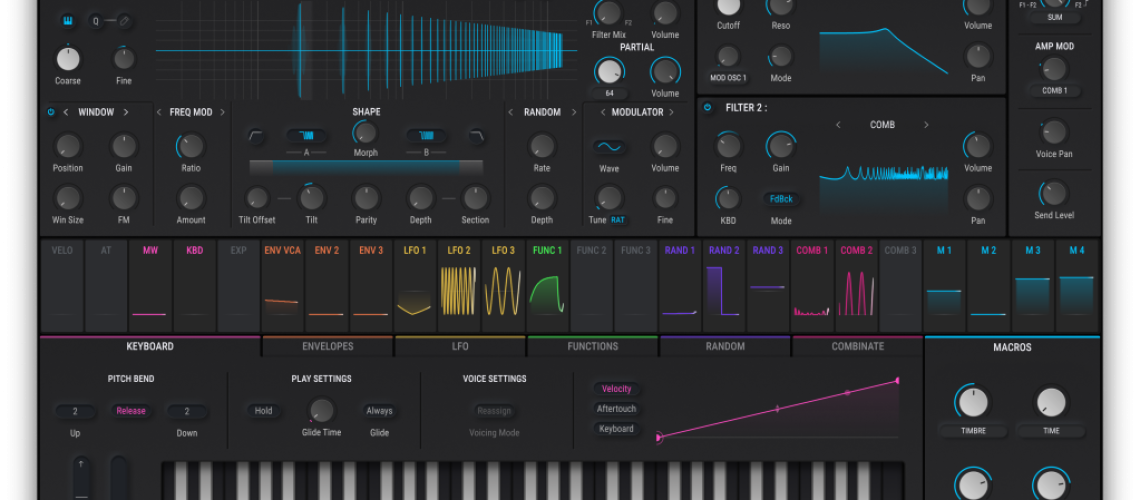Arturia’s polysynth software flagship now adds a generative, polymetric/polyrhythmic sequencer and the ability to process external audio inputs, along with other features. It’s also easier on the CPU, and this is a free update. Here’s what’s new in Pigments 5 – and how to dive into its best sound and sequencing features right away.
You have a choice in epic polysynth plug-ins with deep sound design capabilities. But few virtual instruments with this kind of depth are quite as clean and friendly as Arturia’s Pigments – yes, even up against rivals like NI’s Massive.
Pigments 5 isn’t necessarily the biggest update Pigments has ever seen feature-wise – maybe a good thing, as this virtual instrument already does so much, adding any more could easily make it overstuffed. But what is here is very, very welcome. If you just told me I could finally use that excellent sequencer from ACID V with Pigments, I’d already be sold.
New in this release:
Generative sequencer


Play View. This is more than just another dumbed-down macro view – it’s a terrific heads-up display for the most significant sound features. It’s a convenience for existing users, and nicely condenses what Pigments actually is for anyone new – so you really get an overview of the two-engine + utility + 2 filter + FX architecture. From this screen, you can:
- Select Engine 1 and Engine 2 type (analog, wavetable, sample, harmonic)
- Choose waveforms / wavetables / samples
- Adjust the engine’s timbral settings (tuning, FM amount, wavetable position, etc.)
- Adjust the amplitude envelope
- Choose filter type, cutoff, resonance for each of the two filters
- Set FX parameters (dry/wet balance, stereo pan)
- Adjust send/return values
That’s in addition to any macro assignments for each patch, and there’s a keyboard with hold and pitch and mod. (The onscreen keyboard also means you can program sounds when you’re away from MIDI controllers, like if you’re me and you’re procrastinating other work at your desk.)
There’s also a pretty rainbow-colored visualizer.
This makes it exceptionally easy to pull up a preset from Arturia’s copious library (or your own sounds) and make subtle or drastic changes to it, useful when you’re focused on other musical flow.

Powerful sequencer with per-lane randomization, polymetric capabilities. This is closely related to the sequencer we saw in ACID V, Arturia’s 303-inspired bassline instrument I reviewed last year. The ACID V sequencer has slide, accent, vibrato, and accent lanes, all as on/off toggles. Pigments gives you per-step adjustable values for slide instead of just the toggle, and adds per-step gate length and velocity (plus an overall velocity value, which scales incoming MIDI velocities). There’s also a greater range for octave and per-step probability.
Most importantly, you get the two best features from the ACID V sequencer. Click the Polymetry toggle, and you can slide sequence length independently for each lane. That opens up some wonderful polymetric and polyrhythmic possibilities and hocketing. Pigments has separate pitch and on/off toggle lanes so that you can give those separate pattern lengths.

As in ACID V, you just drag from the right-hand edge to change each lane’s length. (Whether this is polyrhythmic or polymetric depends on the context and … doesn’t really matter. It sounds cool.)

There’s more! Each lane has its own trig divider, so you can run these at different rates. (That’s definitely polyrhythmic, as the overall meter stays the same, though again it totally doesn’t matter whether you get into that.)

And you have overall scale settings, overall randomization, and per-lane randomization amounts for quickly generating patterns:

Oh, if you do own ACID V, you can use the two together. The Pigments sequencer can also output MIDI, so nothing is stopping you from routing MIDI out of Pigments back to ACID V (or any 303 plug-in, for that matter). Not only does that give you an acid line doubling the Pigments part, but you also get this sequencer’s additional features.
This is still a monophonic sequencer – if you really want a polyphonic sequencer, you probably want to just use your host anyway. But it’s easy and great fun to use. You can also store your own presets, so whether you pull up saved melodic ideas or mess around with randomization, you’re never far from some inspiration.
I’ll try to do a video on this one separately, if you’re interested.
External audio input

External audio input. This is also a big one, even if it’s a little tricky to find. You can now route external audio input through Pigment’s engine. That means you can shape the amplitude of the sound – it’s a great way to gate rhythmic sources, for instance – and run inputs through Pigment’s filters, effects, and modulation.
In one step, that turns this into another powerful effects tool; it can be easier to get results this way than with a lot of specialized effects plug-ins. (It means Arturia is again competing with itself; there’s some overlap between what you might do inside Pigments and how you might use something like Efx Motions, introduced in the fall, though each has its own specializations.)
Here’s how to go about it:
First, route sidechain input in your host. There’s no dedicated FX version of the Pigments plug-in; you’ll still use it as an instrument, which is easier anyway as it means MIDI input and whatnot are all routed properly. That will vary from DAW to DAW, but here it is in Ableton Live:

Next, select the Utility Engine. I wish Arturia had used its new Play page to make this a little more accessible, but you need to dive into Synth > Utility Engine > Noise 2.

Change Noise 2 to Audio Input. This will select the external sidechain audio and route it into the Utility engine.

Adjust the filters. You actually have up to three filters to apply to your external audio. From left to right: first, there’s an internal LP / HP filter in the Utility Engine. Then, you can adjust filter Mix F1 / F2.

Look at all that free space in that screenshot, though. I’d love it if Arturia added some other routing options (like pre/post filter, for one). But keep in mind, you then have all the usual Pigments controls here (including how the filters are routed across voices). And you also still have the OSCILLATOR and NOISE 1 sources in the Utility engine, even before you start layering the other engines.
Adjust the Utility gain. Back on Play, you can adjust overall balance of the Utility Engine with the other two engines. How good is this? Well, just making a screenshot, without looking I tried routing a randomized ACID V sequence into a preset, and it sounds kind of accidentally amazing.

Again, if you’d like to see a video on this and some presets, we can go there. Apart from the tutorials, it doesn’t appear that Arturia has built audio input presets just yet, so … enter CDM.
More content, better performance

And more features…
Reduced CPU consumption. My M1 Pro Max is already overkill for anything I’ve thrown at it in polysynths, but if you’ve got an older CPU, I’m told you’re likely to notice improved performance.
More content, with complete MPE mapping. There are 100 new factory presets, and new wavetables and samples, making this toybox even bigger than before both for preset surfers and sound designers alike. Arturia also says they’ve emphasized adding expressive parameter mappings with MPE, which is great news given the growing number of instruments and controllers that support MPE, from Ableton Push 3 to Osmose.
Preset expansions. Here’s where some additional stuff is a paid add-on – there are three Explorations sound banks with 150 presets in each; they’re offering some reduced pricing on that. To be honest, I was too busy with the rest of this to even look, but it’s there.
Everything is a store now, so of course there’s that… (though, again, don’t mind me, I’ll be messing around with audio input for the next six months…)

Conclusions
Pigments has a ton of competition, but it’s really tough to beat the elegance and simplicity of the UI.
You should definitely check out Surge XT for lots of nerdy features and community support and because it’s free and open source. And it’s hard not to notice the similarities in MInimal Audio’s Current, which now is also available without a subscription – both even now have a store for whatever reason, not that I’ve found I can even exhaust what’s already there. NI’s Massive I haven’t reviewed in its present state, but it’s deep. We are spoiled for choice; there are plenty of others (U-he!) I can’t even get into comparing.
What I do like about Pigments is that for all its depth, it has some real character. I think it’s the gold standard as far as navigating the UI. And add this fun sequencer and audio input, and it has something that can be lacking in its rivals – immediacy.

It’s easy to lose sight of this, but software instruments have come a long way. The complexity and feature set can quickly become massive walls of parameters, but looking at something like Pigments, this generation is also getting refinement and navigability. Much as these are blank canvases, you can start to navigate them like instruments. And no complaints here: devoting time to sound design with these is a joy.
Let us know if there’s more you’d like to see.
Pigments 5 is on sale now at 50% off intro price from Plugin Boutique
If you buy something from a CDM link, we may earn a commission.




